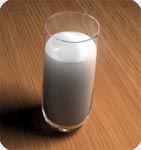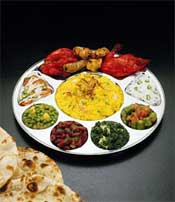|  Do
milk packets like nandini and others contain fat or not? How frequently
is it advisable to consume paneer for a 20-year-old boy? Do
milk packets like nandini and others contain fat or not? How frequently
is it advisable to consume paneer for a 20-year-old boy?
Most milk packets
contain fat. Nandini however has two types; the red packet is whole
milk, which contains the whole normal fat that is present in cow’s
milk (6%). The blue packet contains less than 3% fat (about 1.5
–2%). Some companies supply skimmed milk, which contains less
than 1% fat. Only those wanting to put on weight may use whole milk
with the full fat content. Normally it is advisable to use less
than 3% fat milk but after removing as much fat as possible by the
following method called ‘skimming’. Heat milk on fire
and bring to boil, do not switch off the fire but lower the flame
and allow milk to simmer on slow fire for 10 minutes. Cool, refrigerate
and remove the cream after 5-6 hours. Use yesterday’s milk
for this morning’s coffee. All those on a weight reduction
diet and those who have cholesterol, triglyceride or diabetic problems
must use milk that has been skimmed as mentioned above.
However during
weight reduction and till cholesterol and sugar levels are brought
down, the ideal thing would be to use skimmed milk powder like Sagar
or Anik spray or packet milk that has less than 1% fat. To use skimmed
milk powder mix 2 heaped or full tablespoons of powder in 1 glass
(200 ml) of warm water. Curd made from this is very enjoyable and
so is buttermilk or lassi and it is safe for consumption whenever
hungry. While on a diet 2-3 glasses of this milk is permitted for
most people. Paneer bought from a store is usually made from whole
milk and therefore quite high in its fat content. I would say consuming
this for a young man should be limited to twice a week.
Today nandini
skimmed milk powder and nilgiri skimmed milk powder are also available.
Besides these
nandini has introduced Good life SLIM, skimmed milk in a liquid
form, ready to use from a sachet. Also Nestle offers Nestle SLIM
in a tetra pack in the liquid form. Either of these may be used
and curd, lassi, buttermilk must also be prepared from the skimmed
milk.
My father-in
– law is a diabetic with bad teeth and difficulty in chewing
chapatti. What alternative food can be given? Is it safe to give
him idly?
 The
basic principle to follow while planning a diabetic patient’s
meal is to try and give whole cereals as far as possible. Whole
cereal means cereals like wheat, ragi, oats, corn, rice, etc., where
the outer covering has not been removed and the grain not polished
too much e.g. Atta is from unpolished wheat. Maida is thoroughly
polished wheat grain powdered. Whole wheat bread or brown bread
is made from atta and white bread from maida. Similarly we have
polished white rice and unpolished brown rice. When we consume the
unpolished cereal, we are consuming more fibre, which is an advantage
for diabetic patients as it delays the rising of blood sugar levels.
It prolongs the digestive process and raises the metabolism. The
basic principle to follow while planning a diabetic patient’s
meal is to try and give whole cereals as far as possible. Whole
cereal means cereals like wheat, ragi, oats, corn, rice, etc., where
the outer covering has not been removed and the grain not polished
too much e.g. Atta is from unpolished wheat. Maida is thoroughly
polished wheat grain powdered. Whole wheat bread or brown bread
is made from atta and white bread from maida. Similarly we have
polished white rice and unpolished brown rice. When we consume the
unpolished cereal, we are consuming more fibre, which is an advantage
for diabetic patients as it delays the rising of blood sugar levels.
It prolongs the digestive process and raises the metabolism.
For your father-in-
law, I would recommend oats or rage porridge or broken wheat porridge
for breakfast. Whole wheat bread too is soft and chewable. Idly
for breakfast is O.K., twice a week as it is made of polished rice.
Avoid idly for 6 pm snack or dinner. Ragi ball for lunch is a good
idea. Broken wheat cooked like rice may replace rice for lunch but
once or twice a week he may take a little rice along with a small
ragi ball. At night whole wheat bread or wheat rice or even phulka
dipped in dhal or curd to soften it may be eaten. |